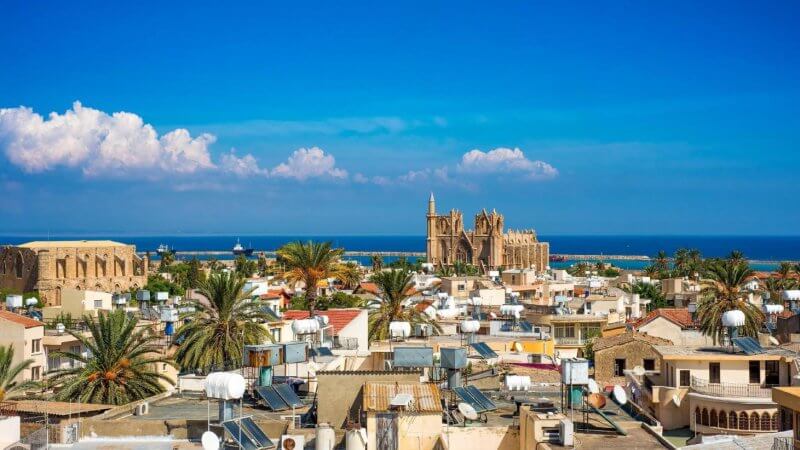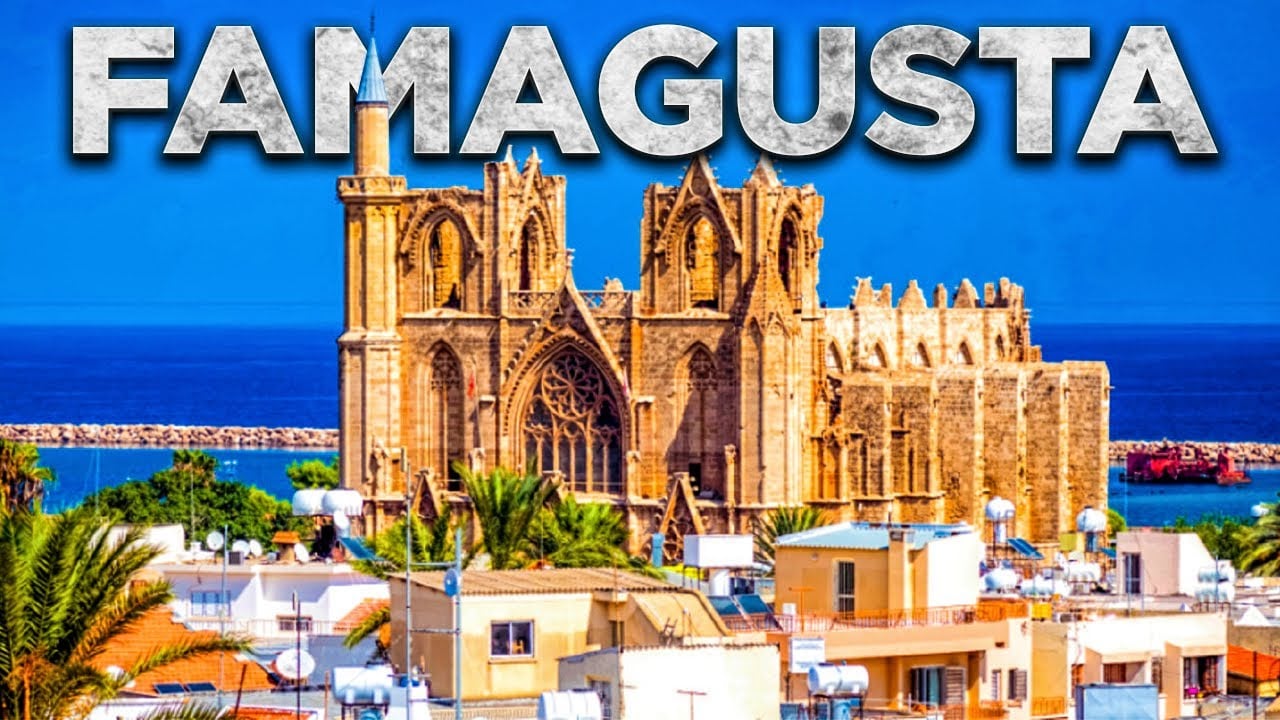Famagusta, Cyprus-a world-famous resort that is visited for a traditional beach holiday on the luxurious beaches of the Mediterranean Sea and discover the unique ancient sights of the ghost town.
General information
Famagusta is a port city located in the south – eastern part of the island on the territory of the Turkish Republic of Northern Cyprus and the administrative center of the area of the same name. The resort is quite small – it has no more than 50 thousand inhabitants. Its convenient location in a natural harbor has made it an important commercial port, and its good climate conditions, comfortable beaches and architectural monuments have made it a popular holiday destination.

But there is one point here. The fact is that back in 1974, a military coup took place on the island, dividing it into 2 communities – Greek and Turkish. As a result of those events, Famagusta became part of the self-proclaimed TRNC. For the average tourist, this means only one thing: to cross the border, they will need a passport. Otherwise, sightseeing is not limited to anything.
The city lies on a picturesque plain planted with olive trees, vineyards, lemons and oranges. The climate is Mediterranean, with subtropical elements, so exotic plants grow on the streets of Famagusta all year round, and the walls of houses and buildings are covered with wild ivy. In winter, this part of Cyprus is warm, but windy and rainy. The coolest winter month is January, when the temperature outside is +8…+15°C.

The best time to travel is from mid-March to July. Precipitation ends by this time, comfortable +22…+25°C are set on the street, and the water heats up to +22°C. In July, the thermometer rises to +30°C, and in late summer and early autumn – to +34…+37°C. True, the sea breeze helps to survive the sweltering heat. Then comes the velvet season, which lasts until the end of October.
Historical background
The history of the ghost town of Famagusta can be divided into several historical epochs.
The city, which later became the most famous resort in Cyprus, was built on the ruins of the ancient Greek Arsinoe. Until 1291, it was a small fishing village, known only for the deep water of the bay. Famagusta became the most important center of the Christian world after the fall of Tyre and the flight of believers from the Holy Land. Many fugitives hoping to return to Palestine settled here. At the end of the 14th century, the city became part of the Republic of Genoa, and 100 years later it was conquered by the Venetians and became the most important trading point in the Levant.
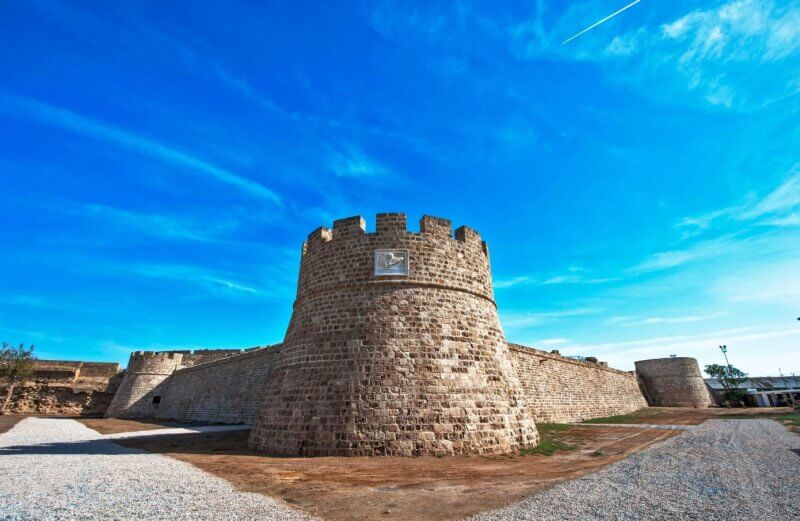
The siege of Famagusta by Ottoman forces began in the autumn of 1570. At first, the advantage was on the side of the Venetians. They held their ground defenses, broke through the harbor blockade, and landed additional forces. But the Turks did not retreat – their numbers increased every day, and sedimentation work was carried out more actively. Despite the artillery barrages, the Venetians held out to the last. The commandant of the city agreed to hold negotiations only in August 1571, when supplies of food and protective equipment ran out. But the Turks played a trick: As soon as the Venetian soldiers came out, they were immediately attacked.British rule
At the end of World War I, Cyprus became a British colony, and Famagusta was designated as the site for the construction of an English military base in the Mediterranean Sea. During this period, the city became a fortified seaport and acquired railway tracks connecting it with Nicosia. At the same time, European-style multi-storey buildings and avenues appeared in it. In addition, the government of the Kingdom actively developed the agricultural sector, drained swamps and engaged in local education.Independent Cyprus
From 1960 to 1974, the city grew significantly. During these 14 years, it has developed into an important transport, tourist and entertainment center with two municipalities – Turkish and Greek. In addition, Famagusta, which at that time was home to only 7% of the population of Cyprus, performed a good amount of industrial work. Factories and factories for the production of clothing, alcoholic beverages, plastics, transport parts, food, etc. were concentrated in the city and its surroundings.Since 1974
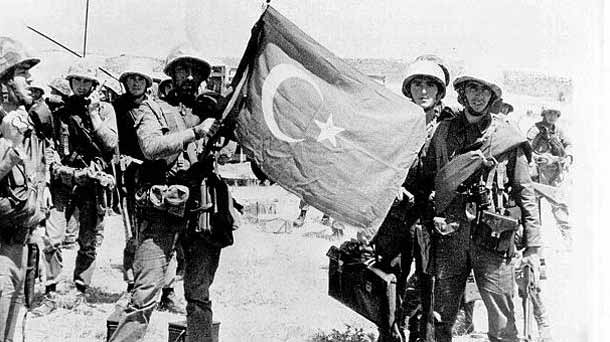
The second Turkish invasion of Cyprus took place on July 20, 1974. In this way, the Turkish authorities reacted to the political upheaval in the country. And already on August 15 of the same year, in just a couple of days, the army occupied the city and expelled the entire Greek population from there. During the bombing of that time, many people were killed – among them were Greek Cypriots, and vacationers. As a result of the annexation, the island was divided into 2 republics of Cyprus – Greek and Turkish, which included Famagusta.
Why is Famagusta called a ghost town?
Why is Famagusta a ghost town? The reason why it was given this name lies in the same occupation of Cyprus by the Turks. Then, in ‘ 74, they closed Varosha, a new residential area that contained the largest number of modern high-rises, hotels, entertainment centers, restaurants, shops, banks and other facilities. The Greeks living in the area were ordered to leave their homes within 24 hours. They were allowed to take only a few bags with them.

Since then, the Varosha quarter has been completely closed to the public – it is surrounded by a fence, looted and devastated. However, in the 90-ies.it began to let journalists in. One of them called the closed area a ghost town.
Famagusta attractions
Walking through the ancient streets of the ghost town of Famagusta, you can see many interesting sights dating back several centuries. If you plan to explore them in one day, book a group or individual tour. But we strongly recommend that you stay here longer.City walls and fortress

The historical part of the ghost town is surrounded by a colossal fortress wall, the height of which reaches 17 m, and the width is from 6 to 9. Behind the fortification, stretching for 3.5 km, hides one of the main attractions of Famagusta. We are talking about the medieval castle of Castello, built by the Lusignans in the northern part of the city. To get to the citadel, you need to cross the bridge over the moat and enter the gate in the arsenal building. The moat was once filled with water, but in the 19th century it was completely drained, thus avoiding a malaria epidemic.
In former times, it was here that the main entrance to the city was located from the direction of Nicosia. The entrance is decorated with a bas-relief depicting a Venetian lion. In the building of the fortress itself, it is allowed to walk along dark stairs and corridors.
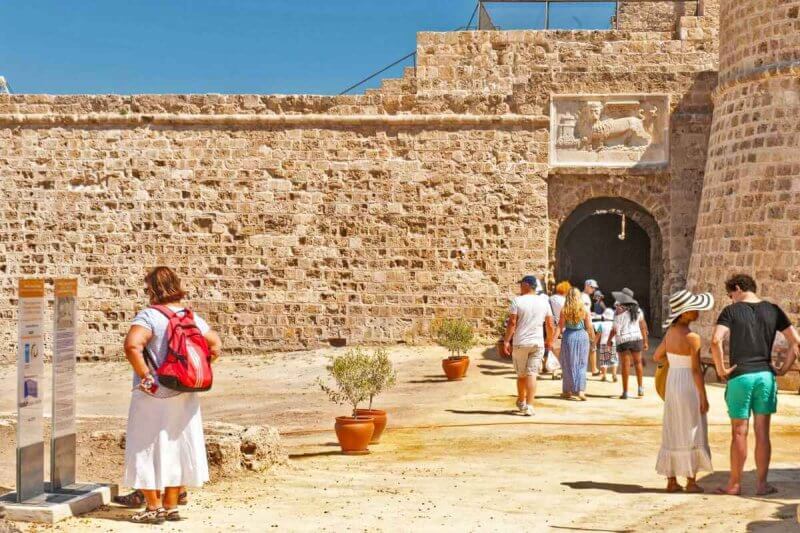
In addition, the fort protected the port of Famagusta from enemy attacks, so it has a Sea gate in the direction of the sea. In case of danger, the harbor was blocked by a chain stretched over the water. It was attached to a Chain Tower mounted on a promontory. Now only a mountain of stones remains from the structure. On the territory of the castle you can see cannonballs made of stones and a collection of ancient cannons made in Turkey and Spain.
There are other architectural attractions in the Old Town:
- The Othello Tower is one of the corner towers of the citadel, offering a beautiful view of the ruins of St. Famagusta Cathedral, cobbled streets, old houses and the market. And it was also here that the tragedy described in the famous play by W. Shakespeare took place.;
- The Church of the Carmelites is a magnificent but already half-ruined cathedral built by the Carmelite Knights;
- The bastion of Jambulat and the grave of a Turkish officer is a religious shrine visited annually by thousands of believers from Turkey.
St. Nicholas Cathedral
St. Nicholas Cathedral in Famagusta was built at the turn of the 13th and 14th centuries on the model of the legendary Notre-Dame de Reims in France. At that time, it was the main Catholic church in the region. After Jerusalem fell, it was here that monarchs were crowned.
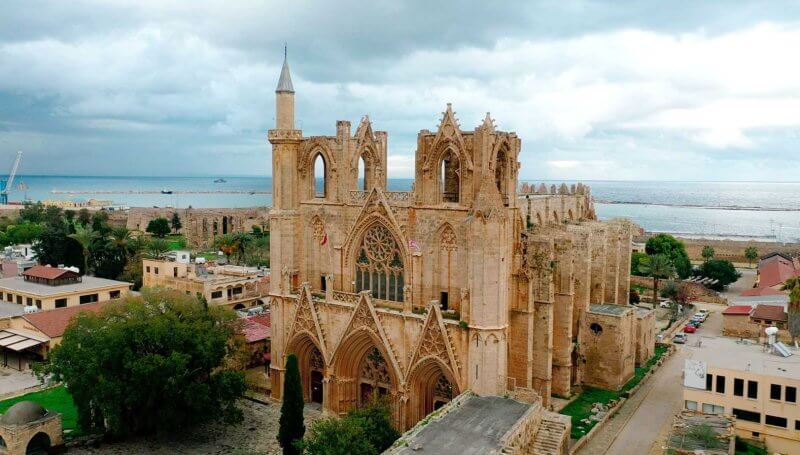
The cathedral, located in the central square of the ghost town, is decorated in the late radiant Gothic style, which is a huge rarity for this area. It consists of 3 naves and measures 23 m wide and 55 m long. The beautiful vaulted ceiling is supported by a colonnade of 12 columns. The facade of the temple faces west. On this side, it has 3 entrances in the form of carved pointed portals. Above the central entrance is a round window-rosette, which resembles a flower. The cathedral is complemented by 2 bell towers, but due to the war with the Ottoman Empire and the earthquake, they are not in the best shape.
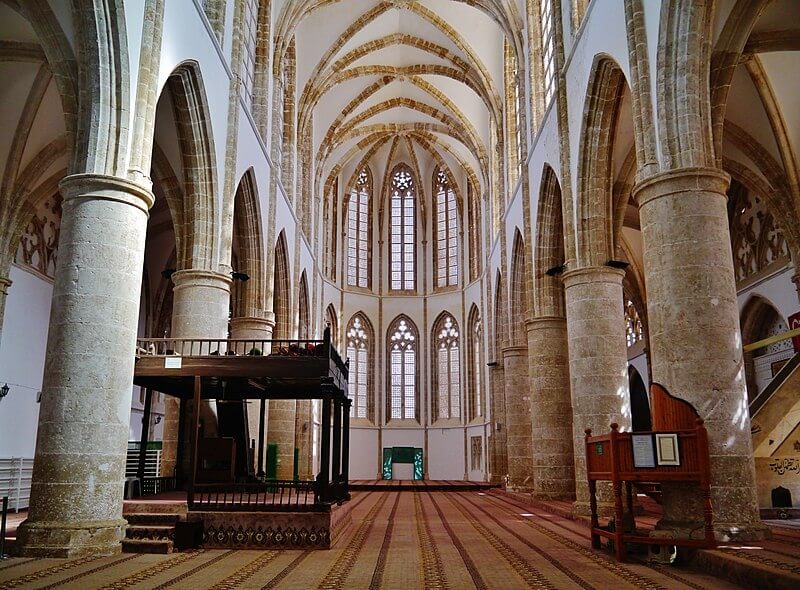
After the capture of Famagusta, the Turks destroyed priceless sculptures, frescoes, crosses, stained glass windows and towers, adding a minaret to one of them. The altar and burial sites suffered the same fate. Since then, the Christian cathedral has become a Muslim mosque named after Lal Mustafa Pasha (the general who led the siege of the ghost town). Next to it grows a fig tree, which was planted during the laying of the foundation and witnessed historical events.
- Address: Mahmut Celaleddin Sokak, Famagusta, Cyprus.
- The opening hours depend on the services.
- Admission is free.
Peter and Paul Church
Many tourist photos of Famagusta show the Church of Peter and Paul, built in the 14th century. Its design combines elements of the Byzantine and Gothic styles. Later, this temple was also made a mosque, and the stained-glass windows, frescoes, and icons were painted over and smashed.
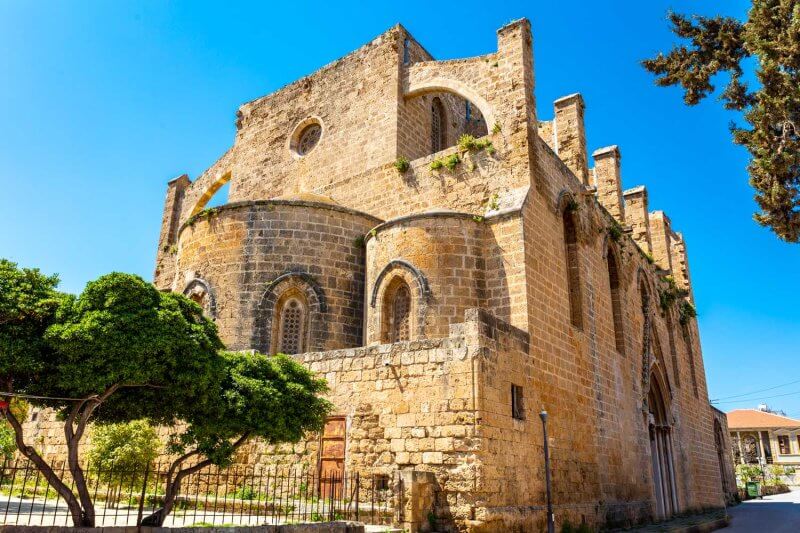
In the first half of the 20th century, when this part of Cyprus was part of Britain, the cathedral was a warehouse for storing grain. Because of this, it was popularly called the Wheat Mosque. When the island regained its independence, Turkish Cypriots held meetings in Sinan Pasha. The building now houses the city’s archives and public library.
Address: 28 Mehmet Celebi Sokak, Ammochostos, Famagusta Cyprus.
Ruins of the Church of St. George of the Latins
Equally noteworthy are the ruins of the Church of St. George the Victorious (Exorinos), built at the end of the 13th century. St George of the Greeks church is a Nestorian cathedral built by the wealthiest urban class of the time. The building, which features medieval frescoes with inscriptions in Syriac, includes elements of Gothic and Byzantine architecture. At the same time, the belfry is made in the French manner.
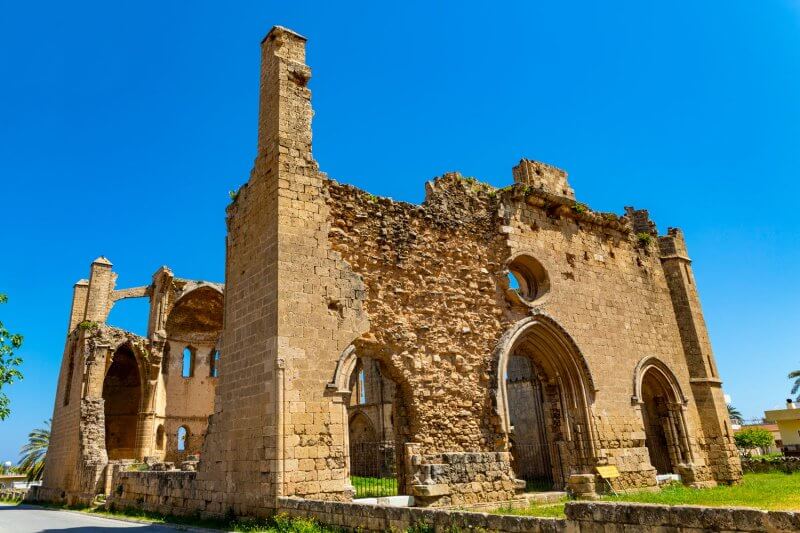
During the Ottoman period, the cathedral was used as a camel pen. Then they were handed over to Greek Orthodox Cypriots. For services, the George of the Greeks Church was opened only in 2013. Now from the once majestic building there are dilapidated walls with fragments of Italian frescoes and what remains of stained glass windows.
Address: 4WFV+JHJ, Lala Mustafa Pasa Sk, Gazimağusa 99450, Famagusta, Cyprus.
Beaches
The city of Famagusta in Cyprus has excellent beaches, among which there are both developed and wild areas. They originate in the suburbs, stretch to the Karpas Peninsula and are separated by isthmuses. The sea here is calm, clean and transparent. The shore is covered with fine sand, the entrance to the water is convenient, the bottom is soft and smooth, and the depth is small, it increases gradually. Large trees grow in undeveloped areas, giving shade and coolness.
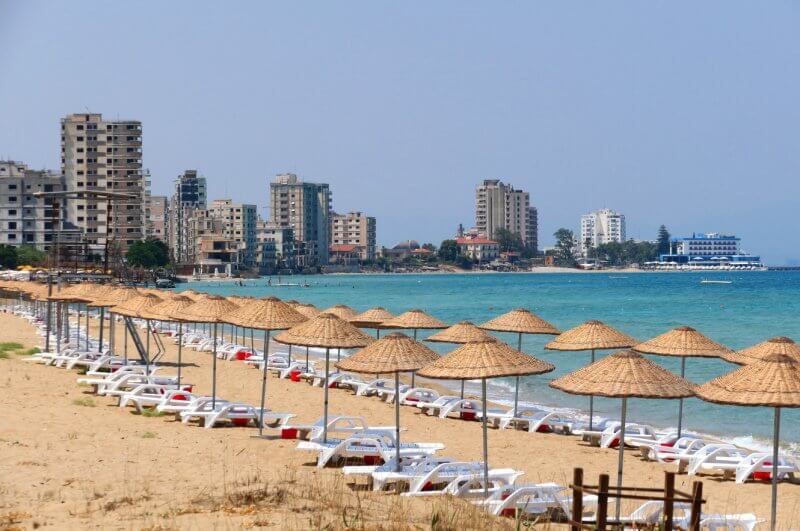
In the afternoon, the sand is very hot, so it is better to take light shoes with you. Almost all recreation areas are equipped with toilets, sun beds, umbrellas, showers, rental points for sports equipment and water transport. The safety of vacationers is monitored by teams of professional rescuers.
There are several beaches in the resort and in the surrounding area. Let’s describe each of them.
Bafra Beach
Quiet and private. You can get there by water or by car. Go in the direction of the Karpas peninsula. Bafra is known for its pristine beauty. There are no entertainment facilities here, so even in the season there are few tourists. For those who like to dive, there is a pier, a restaurant on the shore.
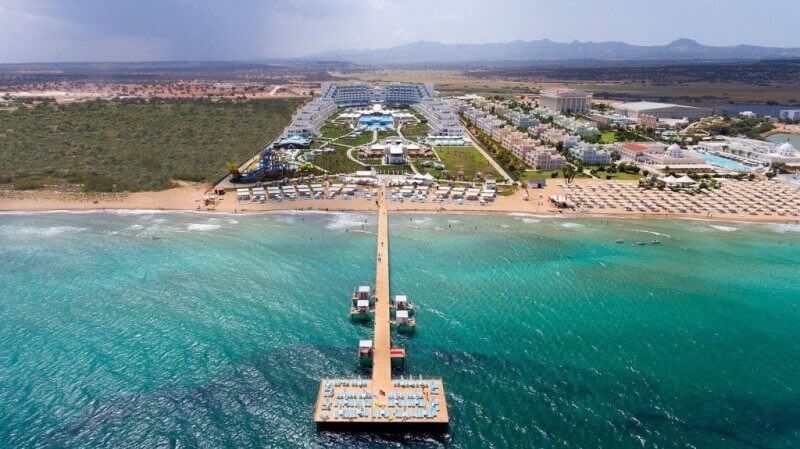
Palm Beach
The only public beach located within the city limits next to the Arkin Palm Beach Hotel. Sandy, with a gentle approach, there are many restaurants and bars around.
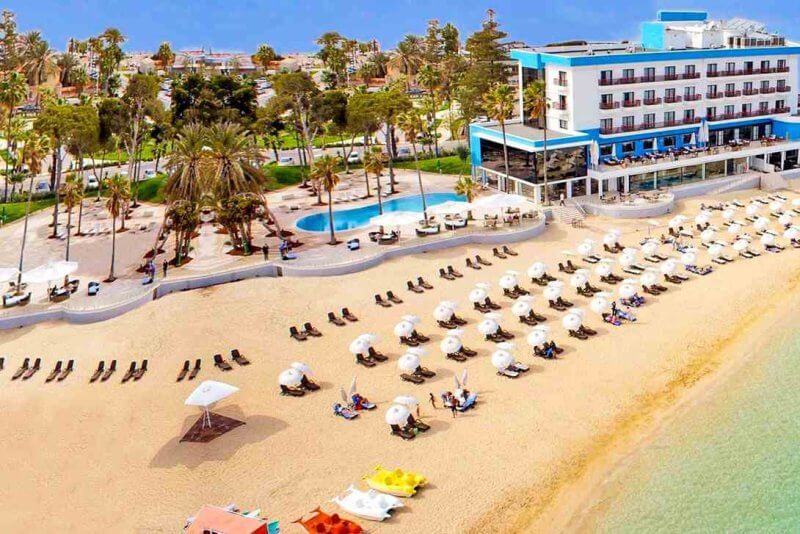
Glapsides Beach
Located 4 km from Famagusta, it has a well-developed infrastructure. The sea here is quiet and shallow, which is sure to be appreciated by couples with children. Nearby there is free Parking, a camping area, restaurants with local cuisine and only, rental of umbrellas and sun beds, as well as sports equipment. In summer, themed parties and entertainment events are held on the beach.

Bediz Beach
Small and picturesque, located in the vicinity of the ghost town. Suitable for family picnics, relaxing holidays and leisurely walks. There are yacht and catamaran rentals available. It doesn’t get crowded even in high season.
Silver Beach
Located 10 km from the center of the ghost town of Famagusta, it is covered with soft silver sand. Great for traditional beach holidays, scuba diving and historical excursions. Eco-friendly. Among the main local attractions are the ancient marble columns.
Where to stay?
Famagusta in Northern Cyprus has a large selection of hotels, mini-hotels, guest houses, apartments, etc. At the same time, the number of places for accommodation increases every year, so you will definitely not have any problems with housing. What is also important, many resort complexes are built near popular city beaches. On their territory there are water parks, night clubs, casinos, cafes, bars, Turkish baths, baths, massage parlors, beauty salons, etc. Active recreation is provided by tennis courts, billiards, bowling, volleyball courts. On the beaches themselves, you can rent water skis, a boat, parachutes or a pleasure yacht.
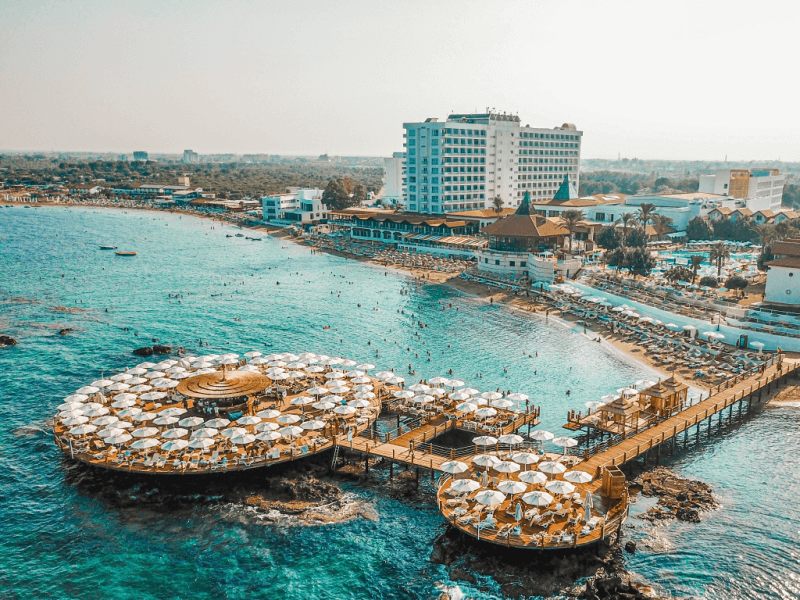
Hotel rooms are divided into several categories, sometimes breakfast is included in the price. Prices depend on the season, as well as the category and location of the hotel. There are also good hotels on the territory of the Old Town inside the fortress walls. Those who plan to stay in Famagusta for a few days and want to save money should look for housing in the vicinity of the city – there are budget bungalows and comfortable hotels.
As for the cost of living in high season (from May to September), a double room in a 5* hotel will cost about 175€, in 4* — from 54€, in 3* and apartments – from 25 €. In local cafes, prices are not very high. Dinner without alcoholic beverages is available for 7-8 € per person.
How to get there from Northern and Southern Cyprus?
The most convenient way to get to the city of Famagusta is from Northern Cyprus. There are regular buses from the Cypriot capital of Nicosia every 30 minutes. The journey takes no more than an hour. Another option is to book an organized day tour with a Russian-speaking guide. Individual tours for 2-4 people are carried out by car and cost from 160 to 180 €. The price of a group tour is from 40 to 50 €. The transfer service is an excursion bus. You won’t be able to enter the city from the Southern part – you’ll need to cross the border in the north first. The nearest checkpoint is in Strovilla. This is the territory of Britain’s own military base.
As for flights, all European flights are accepted by the airport in the city of Larnaca. It is 39 km from Famagusta. You can overcome them by taking an economy class taxi designed for 4 passengers. The cost of one trip is 70€. You can also use a minibus for 5-7 people with an impressive amount of luggage. It will cost 120-130 €.
Those planning to visit Northern Cyprus will have to fly via Turkey – for example, from Istanbul to Ercan Airport, located 41 km from Famagusta.
Cyprus Adults-Only Hotels for a Perfect Romantic Retreat
Interesting facts
The ghost town of Famagusta holds many more secrets and interesting facts. Here are just a few of them:
- In the Middle Ages, it was called the city of 365 churches. The Greeks, Armenians, Syrians, Byzantines, French and Italians built their temples here, which helped spread Christianity throughout the island. Every day the faithful came to listen to the sermon in the new church. It took exactly one year to visit each of them. Now in the city landscape you can see the ruins of only 20 cathedrals. Moreover, many of them were turned into madrassas and mosques by the Turks, and souvenir shops, bakeries and taverns were placed in the rebuilt chapels.
- Several mystical stories are connected with the cathedrals of Famagusta. For example, when the plague swept Europe in the Middle Ages, an envoy of the Pope came to the city on a special mission. He held a divine service in the Church of St. John the Baptist. St. Nicholas and walked around the streets in a religious procession. The chronicles say that after that, there was no more plague in Cyprus.
- In different languages, the name of the ghost town sounds like this: in English –Famagusta, in Greek-ΑμμόχΩστο, in Turkish – Gazimağusa. But at first they called him Arsinoe.
- Celebrities such as Brigid Bardot, Elizabeth Taylor, Raquel Welch and Richard Burton have visited the closed quarter of Varosha in Famagusta, Cyprus.

